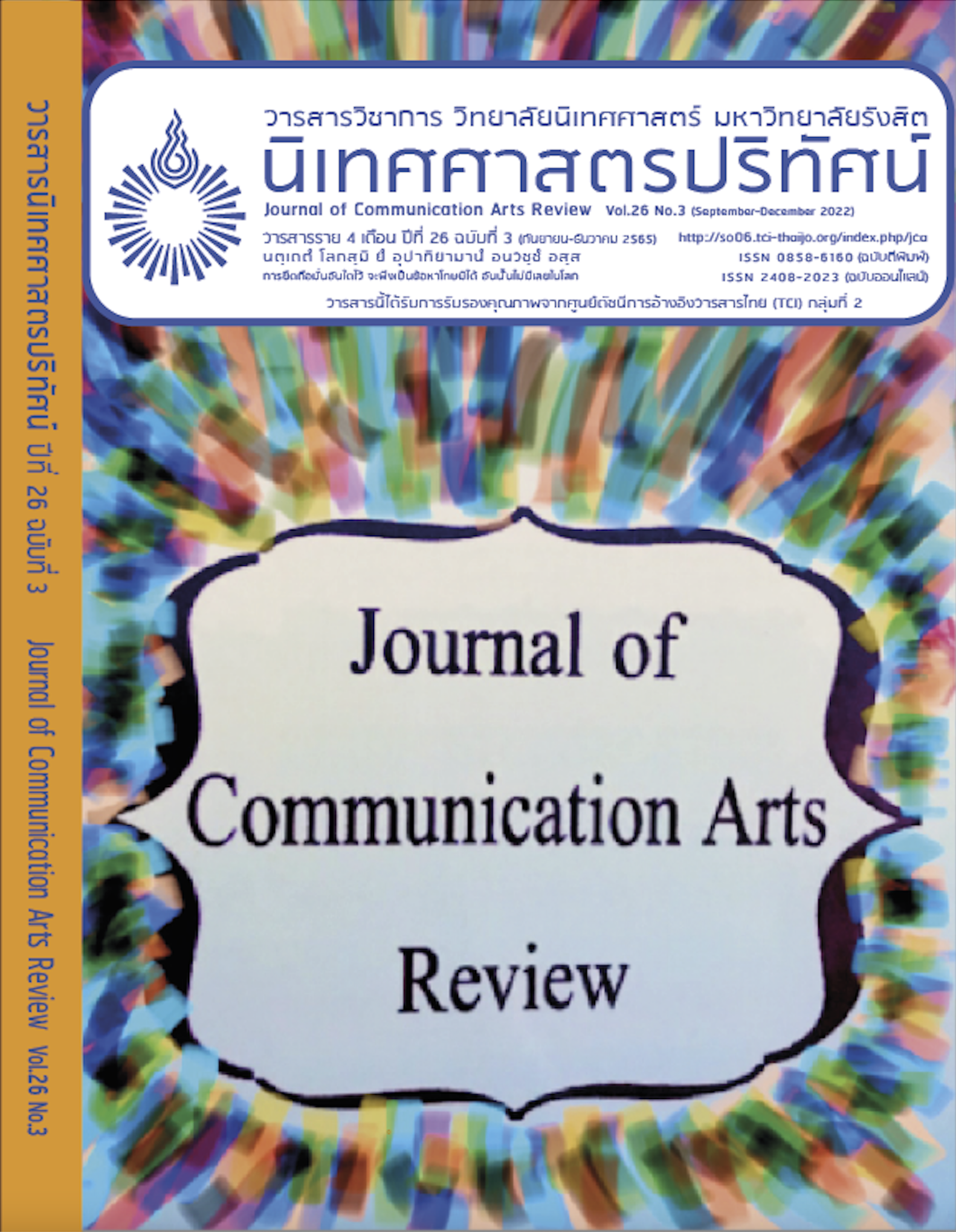อิทธิพลของการรับรองทางสังคมต่อความน่าเชื่อถือข่าวปลอมด้านสุขภาพ บนเฟซบุ๊กของนักศึกษาระดับปริญญาตรี
คำสำคัญ:
ข่าวปลอม, การรับรองทางสังคม, ความน่าเชื่อถือของข่าวสารบทคัดย่อ
งานวิจัยนี้มีวัตถุประสงค์เพื่อศึกษาอิทธิพลของการรับรองทางสังคม (Social Endorsement) ที่มีต่อความน่าเชื่อถือของข่าวปลอม (Message Credibility) ด้านสุขภาพบนเฟซบุ๊ก การศึกษาครั้งนี้เป็นการวิจัยแบบ Mixed Design โดยสุ่มกลุ่มตัวอย่างแบบตามสะดวก (Convenience Sampling) จากประชากรนักศึกษาระดับปริญญาตรี มหาวิทยาลัยธรรมศาสตร์ที่ลงทะเบียนเรียนในรายวิชาจิตวิทยา จำนวน 423 คน โดยแบ่งผู้เข้าร่วมการวิจัยออกเป็น 3 กลุ่มเงื่อนไขตามระดับการรับรองทางสังคม ได้แก่ กลุ่มระดับสูง กลุ่มระดับต่ำ และกลุ่มไม่ระบุระดับจากนั้นให้ผู้เข้าร่วมการวิจัยดูบทความข่าวสุขภาพทั้งหมด 20 บทความ ประกอบด้วยข่าวจริงจำนวน 10 ข่าว และข่าวปลอมจำนวน 10 ข่าว หลังจากนั้นให้ผู้เข้าร่วมการวิจัยประเมินความน่าเชื่อถือที่มีต่อข่าวสารนั้น ข้อมูลที่ได้จะถูกวิเคราะห์ด้วยความแปรปรวนสองทางแบบผสม (Two-way Mixed-design ANOVA) ผลการวิจัยพบว่า ประเภทตามความจริงของข่าวแต่ละรูปแบบ (ข่าวจริงและข่าวปลอม) มีอิทธิพลต่อความน่าเชื่อถือของข่าวสาร โดยข่าวจริงมีอิทธิพลต่อความน่าเชื่อถือของข่าวสารมากกว่าข่าวปลอม ซึ่งอาจเกิดจากการที่ผู้เข้าร่วมการวิจัยมีประสบการณ์ก่อนหน้าเกี่ยวกับข้อมูลจริงมาก่อนแล้ว ผลการวิจัยยังพบอีกว่าระดับการรับรองทางสังคมแต่ละระดับไม่มีอิทธิพลต่อค่าเฉลี่ยคะแนนความน่าเชื่อถือของข่าวสาร ถึงแม้ว่าจะมีจำนวนไลก์เป็นตัวชี้นำก็ตาม ซี่งอาจบ่งบอกว่าจำนวนไลก์เพียงชี้ให้เห็นว่าผู้คนสนใจหรือชื่นชอบข่าวนั้นเท่านั้น โดยสิ่งที่มีอิทธิพลอาจเป็นองค์ประกอบอื่น ๆ บนเฟซบุ๊ก เช่น ปุ่มแสดงความรู้สึก การแสดงความคิดเห็น และการแชร์ เป็นต้น การศึกษาในอนาคตจึงควรเพิ่มองค์ประกอบดังที่กล่าวไปข้างต้น เพื่อศึกษาความเป็นไปได้ที่องค์ประกอบเหล่านี้อาจมีอิทธิพลต่อความน่าเชื่อถือของข่าวสาร และทำให้รูปแบบข่าวในการทดลองมีความสมจริงเหมือนสภาวะที่เกิดขึ้นจริงบนสื่อสังคมออนไลน์มากขึ้น
เอกสารอ้างอิง
กระทรวงดิจิทัลเพื่อเศรษฐกิจและสังคม. (2563, 2 พฤศจิกายน). “พุทธิพงษ์” เปิดงานสัมมนาสร้างการรับรู้เท่าทันข่าวปลอมพื้นที่ ภาคใต้. https://www.mdes.go.th/news/detail/3891--พุทธิพงษ์--เปิดงานสัมมนาสร้างการรับรู้เท่าทันข่าวปลอมพื้นที่ภาคใต้
ฐิติพล ปัญญาลิมปนันท์. (2560, 2 ตุลาคม). ข่าวปลอมในไทย: คุณควรกังวลแค่ไหน?. BBC News ไทย. https://www.bbc.com/thai/thailand-41438401
ไทยรัฐออนไลน์. (2564, 16 กรกฎาคม). เผยสถิติ 9 เดือน ไทยแชร์ข่าวปลอม 20 ล้านคน เป็นผู้โพสต์เองเกือบ 6 แสน.https://www.thairath.co.th/news/politic/2142330
สถาบันวิจัยและพัฒนา มหาวิทยาลัยราชภัฏบ้านสมเด็จเจ้าพระยา. (2563, 15 มีนาคม). คน กทม คิดว่าข่าวปลอมจะทำให้เกิดความเข้าใจผิดและนำไปสู่ความขัดแย้ง ร้อยละ 65.5 % 75.7 % เจอข่าวปลอม (Fake News) เจอมากที่สุด ในเฟซบุ๊ค 50.1 % กับเรื่องการเมือง 32.7 %. http://research.bsru.ac.th/คน-กทม-คิดว่าข่าวปลอมจะท/
สำนักงานราชบัณฑิตยสภา. (2563). พจนานุกรมศัพท์นิเทศศาสตร์ ฉบับราชบัณฑิตยสภา. กรุงเทพฯ: สำนักงานราชบัณฑิตยสภา.
Agarwal, N., & Yiliyasi, Y. (2010). Information quality challenges in social media. ICIQ. https://www.semanticscholar.org/paper/Information-quality-challenges-in-social-media- Agarwal-Yiliyasi/ece848ac7435350acdb54a5a661f611f9325cbc1
Appelman, A., & Sundar, S. S. (2016). Measuring Message Credibility. Journalism & Mass Communication Quarterly, 93(1), 59–79.
Bond, R. M., Settle, J. E., Fariss, C. J., Jones, J. J., & Fowler, J. H. (2016). Social Endorsement Cues and Political Participation. Political Communication, 34(2), 261–281.
Brand Buffet. (2560, 17 ตุลาคม). ใจดี โลกสวย เชื่อคนง่าย!!! คนไทย 40% เชื่อข่าวปลอมบนโซเชียลสูงสุดในภูมิภาค.
Chen, S., Duckworth, K., & Chaiken, S. (1999). Motivated Heuristic and Systematic Processing. Psychological Inquiry, 10(1), 44–49.
Clayton, K., Blair, S., Busam, J. A., Forstner, S., Glance, J., Green, G., Kawata, A., Kovvuri, A., Martin, J., Morgan, E., Sandhu, M., Sang, R., Scholz-Bright, R., Welch, A. T., Wolff, A. G., Zhou, A., & Nyhan, B. (2019). Real Solutions for Fake News? Measuring the Effectiveness of General Warnings and Fact-Check Tags in Reducing Belief in False Stories on Social Media. Political Behavior.
Dale, S. (2015). Heuristics and biases. Business Information Review, 32(2), 93–99.
Giudice, K. D. (2010). Crowdsourcing credibility: The impact of audience feedback on Web page credibility. Proceedings of the American Society for Information Science and Technology, 47(1), 1–9.
Guadagno, R. E., Muscanell, N. L., Rice, L. M., & Roberts, N. (2013). Social influence online: The impact of social validation and likability on compliance. Psychology of Popular Media Culture, 2(1), 51–60.
Herfst, J. (2020). Fake news, who’s opinion do we trust? The mass or an authority? [Master’s Thesis]. Tilburg University.
Higdon, N. (2020). The anatomy of fake news: A critical news literacy education. University of California Press.
Lewandowsky, S., Ecker, U. K. H., Seifert, C. M., Schwarz, N., & Cook, J. (2012). Misinformation and Its Correction. Psychological Science in the Public Interest, 13(3), 106–131.
Malhotra, A., Malhotra, C. K., & See, A. (2013). How to create brand engagement on Facebook. MIT Sloan Management Review, 54(2), 18-20.
Merriam-Webster. (2018). Merriam-Webster Dictionary. Merriam-Webster.com.
Messing, S., & Westwood, S. J. (2012). Selective Exposure in the Age of Social Media. Communication Research, 41(8), 1042–1063.
Milord, J. T., & Perry, R. P. (1977). A Methodological Study of Overloadx. The Journal of General Psychology, 97(1), 131–137.
Oh, J., Bellur, S., & Sundar, S. S. (2015). Clicking, Assessing, Immersing, and Sharing: An Empirical Model of User Engagement with Interactive Media. Communication Research, 45(5), 737–763.
Oxford Dictionary. (2017). Oxford Learner’s Dictionaries | Find definitions, translations, and grammar explanations at Oxford Learner’s Dictionaries.
Ozdalga, D. (2018). Fake News and Social Endorsement Cues: Do the Number of Likes, Shares and Comments Influence Engagement with Inaccurate News Articles?. [Master’s Thesis]. Yale University
Pennycook, G., Cannon, T. D., & Rand, D. G. (2018). Prior exposure increases perceived accuracy of fake news. Journal of Experimental Psychology: General, 147(12), 1865–1880.
Pentina, I., & Tarafdar, M. (2014). From “information” to “knowing”: Exploring the role of social media in contemporary news consumption. Computers in Human Behavior, 35, 211–223.
Sakamoto, Y. (2010). The Impact of Collective Opinion on Online Judgment. Proceedings of the Annual Meeting of the Cognitive Science Society, 32.
Salganik, M. J. (2006). Experimental Study of Inequality and Unpredictability in an Artificial Cultural Market. Science, 311(5762), 854–856.
Snelting, T. M. C. (2019). Encouraging critical evaluation on Facebook to fight disinformation [Master’s Thesis]. Radboud Nijmegen University.
Sundar, S. S. (2008). The MAIN model: A heuristic approach to understanding technology effects on credibility.
Tversky, A., & Kahneman, D. (1974). Judgment under Uncertainty: Heuristics and Biases. Science,185(4157), 1124–1131.
Yang, C. C., Chen, H., & Hong, K. (2003). Visualization of large category map for Internet browsing. Decision Support Systems, 35(1), 89–102.
ดาวน์โหลด
เผยแพร่แล้ว
ฉบับ
ประเภทบทความ
สัญญาอนุญาต
ลิขสิทธิ์ (c) 2022 วารสารนิเทศศาสตรปริทัศน์

อนุญาตภายใต้เงื่อนไข Creative Commons Attribution-NonCommercial-NoDerivatives 4.0 International License.


